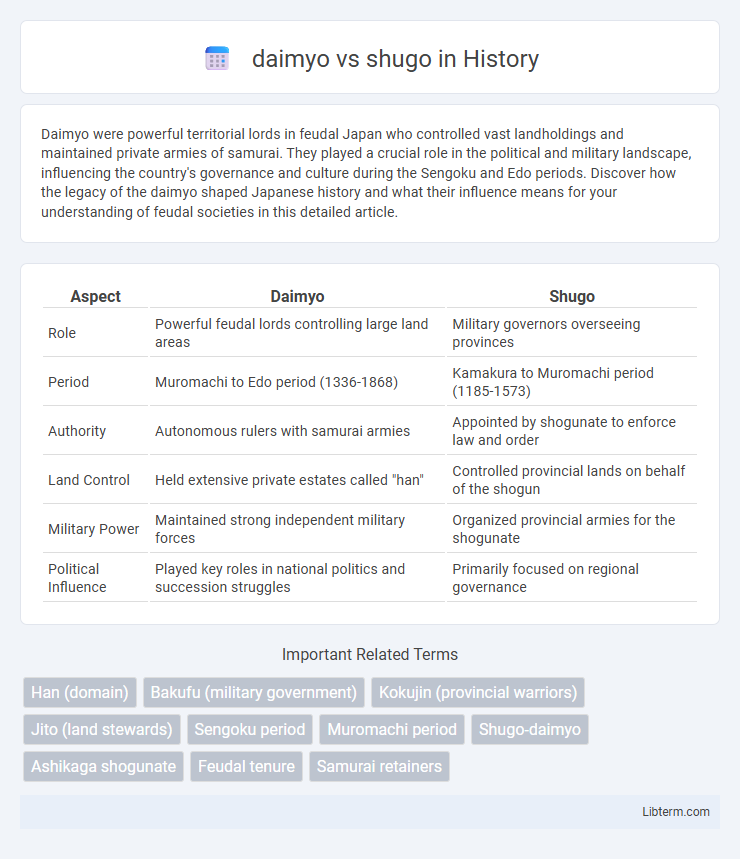Daimyo were powerful territorial lords in feudal Japan who controlled vast landholdings and maintained private armies of samurai. They played a crucial role in the political and military landscape, influencing the country's governance and culture during the Sengoku and Edo periods. Discover how the legacy of the daimyo shaped Japanese history and what their influence means for your understanding of feudal societies in this detailed article.
Table of Comparison
| Aspect | Daimyo | Shugo |
|---|---|---|
| Role | Powerful feudal lords controlling large land areas | Military governors overseeing provinces |
| Period | Muromachi to Edo period (1336-1868) | Kamakura to Muromachi period (1185-1573) |
| Authority | Autonomous rulers with samurai armies | Appointed by shogunate to enforce law and order |
| Land Control | Held extensive private estates called "han" | Controlled provincial lands on behalf of the shogun |
| Military Power | Maintained strong independent military forces | Organized provincial armies for the shogunate |
| Political Influence | Played key roles in national politics and succession struggles | Primarily focused on regional governance |
Introduction to Daimyo and Shugo
Daimyo were powerful feudal lords who controlled vast landholdings and maintained private armies during Japan's Sengoku period, shaping political and military landscapes. Shugo were regional military governors appointed by the shogunate in the Kamakura and Muromachi periods, responsible for maintaining law and order and overseeing land administration. The evolution from shugo to daimyo marks a shift from appointed governance to autonomous regional rule, a critical development in feudal Japan's power structure.
Historical Origins of Daimyo and Shugo
The historical origins of daimyo trace back to powerful territorial lords in feudal Japan who consolidated land and military power during the Sengoku period. Shugo were military governors appointed by the Kamakura and Muromachi shogunates to oversee provinces and maintain order, often evolving into daimyo as they gained hereditary control and expanded authority. The transition from shugo to daimyo signifies the shift from centralized military oversight to regional autonomy and feudal lordship in Japanese history.
Roles and Responsibilities Compared
Daimyo were powerful territorial lords who governed large domains and maintained private armies, responsible for tax collection, law enforcement, and regional military defense during Japan's feudal era. Shugo were military governors appointed by the shogun tasked with overseeing provincial administration, maintaining public order, and supervising the daimyo within their jurisdiction. While daimyo exercised autonomous control over their lands, shugo held official authority delegated by the central shogunate to enforce political and military oversight.
Authority and Governance Structure
Daimyo held autonomous military and territorial control as powerful feudal lords governing vast domains, often exercising hereditary authority supported by samurai retainers. Shugo were provincial military governors appointed by the shogunate, tasked with maintaining order and overseeing regional administration, but their power was more directly linked to central authority and often constrained by the shogun's mandates. The governance structure positioned daimyo as semi-independent rulers with significant local autonomy, whereas shugo functioned as representatives of the central military government, balancing regional control with loyalty to the shogunate.
Relationships with the Imperial Court
Daimyo were powerful territorial lords who often maintained direct or indirect relationships with the Imperial Court to legitimize their regional authority, whereas shugo were originally military governors appointed by the shogunate to oversee provinces and enforce its policies. The daimyo's interaction with the Imperial Court evolved as they gained more autonomy, sometimes engaging in court rituals to bolster their prestige. Shugo generally held less independent influence at court, serving more as extensions of shogunal power rather than autonomous political entities.
Military Power and Land Control
Daimyo held greater military power than Shugo, commanding larger armies of samurai due to their extensive landholdings and resources. While Shugo were initially appointed as provincial military governors by the shogunate, daimyo evolved into autonomous lords exercising direct control over vast territories. This shift allowed daimyo to consolidate land control, strengthen fortifications, and exert significant influence during Japan's feudal era.
Evolution Through Japanese History
Daimyo initially emerged as powerful territorial lords during the Muromachi period, evolving from the earlier shugo, who were military governors appointed by the shogunate to oversee provinces. Over time, daimyo consolidated their control through strategic land acquisitions and vassal networks, surpassing shugo in political and military influence by the Sengoku period. This transition marked a significant shift in Japan's feudal hierarchy, paving the way for centralized domains under daimyo leadership.
Key Differences in Political Influence
Daimyo held extensive autonomous power over large domains, functioning as hereditary lords with strong military and economic control during the Sengoku period. Shugo were provincial military governors appointed by the Ashikaga shogunate, with responsibilities to oversee law enforcement and tax collection, but their authority was often limited and occasionally contested. Unlike shugo, daimyo exercised more independent political influence, gradually eclipsing shugo by consolidating local power and establishing private armies.
Decline and Legacy of Daimyo and Shugo
The decline of daimyo and shugo was marked by the centralization of power under the Tokugawa shogunate, which reduced their autonomous control over provinces and shifted them to more symbolic roles. Shugo, originally military governors during the Kamakura period, saw their influence wane as daimyo consolidated power and established more stable feudal domains (han) during the Sengoku period. The legacy of daimyo and shugo endures in Japanese history through their contributions to the feudal system, regional governance, and the cultural development that influenced the Edo period's political stability and social order.
Daimyo vs Shugo: Lasting Impact on Japan
Daimyo and shugo played crucial roles in shaping Japan's feudal system, with daimyo eventually evolving into powerful territorial lords who controlled vast domains and maintained private armies. Shugo, initially appointed as military governors by the shogunate, gradually saw their authority diminish as daimyo consolidated more regional power. The lasting impact of daimyo is evident in Japan's political structure, influencing the transition to centralized rule and the development of the samurai class during the Sengoku and Edo periods.
daimyo Infographic

 libterm.com
libterm.com